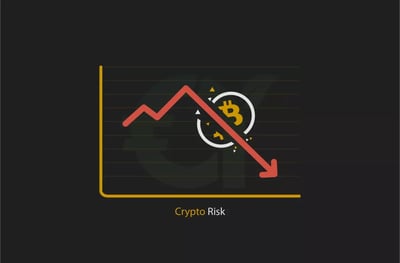Table Of Contents
- What Is the Meaning of Shorting Crypto?
- Risks of Short-Selling Cryptos
- Limitless losses
- Margin interest
- How to Short Crypto?
- Direct short selling
- Margin trading
- Futures markets
- Contracts for difference
- Crypto put options
- Binary options
- Prediction markets
- How-to Tips for Shorting Cryptos
- Use technical analysis
- Stay current with the news
- Use fundamental analysis
- On-chain metrics
- Transaction count
- Transaction value
- The Bottom Line
How to Short Crypto? 2026 Full Guide
As a trader, if I had to describe the one inherent characteristic of the crypto market, it would be volatility. A crypto asset running smoothly today may well experience an unexpected drop tomorrow. This would explain why the value of many cryptocurrencies constantly changes throughout the day. Such volatility, along with regulatory actions, may well lead to flash crashes caused by market fear, followed by minor retracements after large rallies. To keep from showing a loss when this occurs, traders can leverage a concept known as “short selling,” which allows them to make money when prices are declining. In this article, I'll explain crypto shorting and the accompanying risks.
Shorting crypto means selling high and buying low later by predicting a drop in asset price.
This strategy carries unlimited loss potential if the price rises, so it requires tight stop-loss use and strong risk management.
Traders can short crypto using direct selling margin trading, futures CFDs, put options, binary options, and prediction markets.
Technical analysis tools like RSI Bollinger Bands and moving averages help traders identify downtrends and price reversals.
Fundamental analysis and staying updated on news and regulations play a key role in timing crypto shorting positions.
On-chain metrics such as transaction count and value can reveal activity trends that support short-selling decisions.
Using leverage with margin trading can increase returns, but magnifies losses if the trade moves against the prediction.
Popular platforms for shorting crypto include Binance Futures, Bybit, FEX, Phemex, and brokers like ICM XTB and IG.

What Is the Meaning of Shorting Crypto?
As a regular trader, I came to learn that shorting crypto is the practice of selling cryptos at a high price to repurchase them at a lower price later, ideally in situations where the crypto asset is predicted to fall.
The approach is called short selling because the trader is “short” on the coins, i.e., doesn’t yet own the crypto from which the trader intends to profit. To help with understanding, you need to be familiar with crypto short and long positions. When going long, the trader purchases cryptos with the expectation that their market value will increase. As an example, if I buy a specific coin at $15 and expect its price to reach $18. Once that price is reached, the trader sells and reaps the profit.
By contrast, short selling is borrowing crypto, selling it at the current market value, and then expecting the value to fall, at which time the trader buys a coin and profits, the difference between the selling and buying prices.
Shorting is an approach to making money from an asset's decline in value. Traders, therefore, can opt for shorting when the expectation is that a coin’s market is about to decrease. Shorting cryptos is risky because markets are often unpredictable. While there is certainly potential for gains, a market’s volatility increases the likelihood of significant losses.
When a trader holds a long position, the crypto’s price may well drop, but rarely to zero. So, even though the trader didn’t make any money on that trade, he still has the original investment. When shorting, a coin's price may rise indefinitely, increasing losses; thus, it is advisable to be certain there is solid research before jumping in. If the trader is confident about the research and is positive that the price will fall, they then take the calculated risk because it could result in significant profit.
Risks of Short-Selling Cryptos
In my view, there is no question that short-selling crypto can lead to profits when the market is down; but you must also consider the associated risks. The following are some noteworthy drawbacks to shorting cryptos:
Limitless losses
When buying and holding crypto with the hope of selling at a higher price, you are only exposed to the risk of ending up with crypto that did not reach the target price. You still have the crypto and may choose to hold it for as long as you wish.
However, the potential losses are unlimited when shorting crypto, as the price can rise above the original investment. If the cryptos continue to rise, you may need to borrow them at a higher price to lessen the average cost if you are still intent on covering the position without incurring losses. That's why inserting a stop-loss order in your trading strategy is a good idea - it sets a natural limit to how much you can lose.
Margin interest
When a trader short-sells crypto, they do not own the crypto. Rather, the trader is borrowing it from a broker, who charges interest for as long as the trader holds the coins. Thus, if the crypto’s price does not decrease as predicted, the trader may need to hold the borrowed coin for a long time. As this is taking place, the interest continues to build, eating into potential profits.

How to Short Crypto?
My advice is that before using any short-selling method for crypto, you must first identify the trend. Because the market is highly volatile, many factors can influence it in either direction, from regulatory changes to broader economic factors. You can use fundamental analysis as a guide, which is the understanding of the macroeconomic environment influencing the coin, or you can use technical analysis instead, which is the study of items like moving averages and charts that reveal the underlying behavior of financial assets.
Now that you understand just what shorting crypto entails, here is more information on how to short crypto via various methods:
Direct short selling
This is the initial approach traders take to shorting crypto. In principle, the trader borrows crypto from the best crypto exchange they can find for a specific price. Next, the trader waits for a price decline. When the price decreases, the trader purchases the currency and returns the borrowed crypto to the exchange. The trader then has earned the difference between the buy and sell prices.
Margin trading
It is said, and I would tend to agree, that the easiest crypto shorting approach is margin trading, which is supported by many crypto exchanges: FEX, Phemex and Binance Futures, to mention just a few. In this approach, the trader borrows crypto from a broker to enter the market. You need to know that “margin” refers to not simply “borrowing” coin from the broker, but borrowing at heavily leveraged rates, which means increasing your profits is not the only possible outcome; there is also the possibility of greater loss because you have borrowed so heavily. Normally, the broker offers a certain percentage of money you are able to borrow from the exchange to use for trading. Then, after a stated number of days, you must return the money you have borrowed to settle the debt.
Futures markets
As with other assets, some cryptocurrencies also have futures markets where traders agree to buy or sell a security through a contract. The contract specifies both the price at which the crypto will be sold and the timing of the sale.
By purchasing a futures contract, the trader bets on the crypto’s price. This approach allows the trader to profit from that crypto in the future. When a trader sells a futures contract, it indicates they expect the price to decline in a forthcoming bear market. Our experts at Arincen have written a detailed article providing trading ideas for a bear market. Crypto futures may be traded on the Chicago Mercantile Exchange, the world's largest trading platform for derivatives, or with ByBit derivatives.
Contracts for difference
Contracts for differences (CFD) are among the most popular approaches to short crypto. Brokers will allow traders who use CFDs to bet on an increase or decrease in a crypto’s price without actually owning the crypto. The trader must only deposit a part of the margin account’s fund to ensure he will be able to purchase the crypto at the specific price on which he is betting. The deposit remains in the trader’s possession and the broker or exchange only holds it as collateral.
Therefore, the trader only needs to supply a specific fraction of the total trade amount to open his position. Because of this, the trader is able to amplify his return on investment if the crypto moves in the direction of the bet. Having said that, CFDs carry enormous risks if the crypto’s price moves in the opposite direction to the trader’s prediction.
Crypto put options
Is it possible to short cryptos without risking your investment? There is an “almost” answer. If a trader deals with complex derivatives in a bear market, the trader is able to add a buying crypto put option to his list of methods on how to short crypto. The option gives the trader the right to buy crypto at a predefined price on a predetermined date. This, however, is not an obligation.
For example, if a trader believes that Bitcoin’s price will drop in the autumn of 2026, he can purchase the crypto for three months with a price of, say, $25,000. If the price drops below this strike price on the predetermined date, the put will earn a trading profit. However, if the price remains high, the trader will not lose anything other than the option premium, which is the fee paid for holding the option.
Binary options
Also available are binary options for shorting cryptocurrency. Well-known concepts are put and call options where you must execute a put order using an escrow or other services. The goal here is to sell the crypto at today’s price, even if, later, the market price drops. Many offshore crypto exchanges offer binary options. Remember, however, this approach involves high cost and risk.
The principal advantage here is limiting losses by not electing to sell the put options. Therefore, you are only taking a loss on the funds spent in the creation of the order. Generally, it is a limited-risk and short-term contract trading approach with two possible outcomes. First, you may make a profit, which you have defined beforehand. Second, you lose the money you put forth to open the trade.
Prediction markets
To learn how to short cryptos while interacting with others, consider this approach, which is similar to mainstream conventional markets.
You may predict that a specific crypto will decrease by a particular percentage or margin. Following the prediction, someone else has to agree to the bet. If the price really goes the way you want, you earn a profit.
Recommended Brokers
How-to Tips for Shorting Cryptos
In my view, as there are several factors that serve as the base for shorting cryptos, you must be certain you are taking the correct approach at the time. The worst situation is to short sell a crypto during a false retracement. Here are some tips to help make the proper decision.
Use technical analysis
Technical analysis (TA) uses real-world data to predict how the crypto market will perform in the future. This requires viewing past performance of the crypto in which you are interested, such as its volume and movement. Thus, if a trader wants to know how to short Solano, they will compare today's trading volume with that in recent months.
TA is based somewhat on Dow Theory, which asserts that market prices depend on factors ranging from current and historical demand and regulations to a trader’s knowledge of the crypto itself and their expectations of future demand for it. TA’s root is that history will repeat itself relative to pricing and trends. All this information is then used to predict future market sentiment.
Furthermore, TA is based on the concept that any movement in the crypto market is not random, but rather is based on a trend – either long-term or short-term. Generally, if a currency has followed a trend, it will eventually reverse and follow the opposing trend.
The following are some indicators that are used in TA to assist with predicting price crashes and retracements:
• Average directional index (ADX) assists with determining the strength of the trend.
• Standard deviation is applied to the annual rate of return on investment and shows the historical validity of investments in a crypto.
• Bollinger Bands demonstrate whether the crypto’s price is low or high on a relative basis.
• Relative strength index (RSI) signifies momentum in TA. For any recent price change, this indicator determines the magnitude.
These indicators allow a trader to determine the profit opportunity with an investment. The trader also is able to use some statistical tools, such as time-weighted averages price (TWAP), Fibonacci ratios and extensions, moving averages (MA), and volume-weighted average price (VWAP).
When learning how to short a crypto, there is a need to understand MAs. Simply, MA refers to a crypto’s price over a certain period. The MA typically depends on the crypto’s trading price over the previous 20 days. It is possible to make predictions more accurate by connection of the moving averages.
All of these approaches are complex statistical concepts and require some learning but will help you develop a good risk management foundation. A novice trader who is still learning to short cryptocurrencies may be cautious about diving into complex economics. Remember that factoring in these indicators will enable more intelligent investment decisions.
Stay current with the news
As an active trader, I make a point of following the news. This is not just crypto news, because politico-economic events can propel a market in any direction. Indeed, it is possible for government regulations and crackdowns to lead to flash crashes in the crypto market.
Therefore, if you suspect that something along these lines is about to take place, capitalize on the situation by shorting cryptos in the bear market. At the same time, be alert not to go against any government guidelines in the process because that could lead you into significant trouble.
Use fundamental analysis
There are those who do not believe cryptocurrencies have any fundamentals at all, given that their markets have only been around for such a short time. It is still possible, however, to use fundamental analysis (FA) to help the chances of making the right investment decisions. When using FA, you uncover the forces that drive the supply and demand of cryptos in which you are interested. Examples of relevant variables are news, trading, market sentiment, adoption and transaction activity.
Using FA, the trader studies the intrinsic value of a crypto. Then the trader views both internal and external factors to decide if a crypto is overvalued or undervalued. Because cryptos’ FA is not the same as that of more traditional markets, three different metrics commonly are used:
On-chain metrics
These metrics may be observed by viewing the data on a blockchain. In fact, the trader does not have to do very much because there are websites that already have generated this data. For example, data charges for various cryptos may be viewed when spot trading on Bybit.
Transaction count
Transaction count also provides a reasonable idea of the activity occurring on a network. The trader is able to use moving averages, and even plot a specific time period, to determine how activity surrounding a crypto changes over time.
Use this metric with caution! The information comes with no guarantee, for example, as to whether a high transaction count is because of unique active addresses or the same people transferring funds among their different wallets.
Transaction value
Transaction value shows the number of completed transactions in a certain time period. Thus, if 10 people transfer Bitcoin in a single day, the transaction count would be 10. If each Bitcoin were worth $1,000, the total transaction value for the day would be $10,000
The Bottom Line
In my experience, when done well, shorting cryptos can be a viable activity. Shorting crypto means selling it at a high price because you expect the price to decline due to fear in the market or retrace following a price rally. This allows you to purchase it later at a lower price. I hope my handy guide helps you understand what shorting crypto is and where to do it legally.
Recommended Brokers
FAQ
Shorting crypto means borrowing an amount of digital currency from a broker and selling it at market value. Then, when the value of the crypto has fallen, the trader purchases it and returns the borrowed amount, plus interest, to the broker. The trader’s profit is the difference between the buy price and the sell price, less the interest.
Is shorting crypto halal? Shorting cryptos normally is considered Haram because it involves selling something that is borrowed. It may, however, be worth consulting your religious leader for guidance.
Several crypto platforms exist on which futures, margin and options contracts can be traded. Among the best known are Coinbase, Binance, Robinhood, Webull, Kraken, eToro, Interactive Brokers, Bitfinex, Cryptohopper and Kucoin.
Short selling is highly regulated in traditional financial institutions. Crypto is unregulated in many jurisdictions, however, such as the US, Australia, India, Canada, and Europe. Traders, therefore, need to be wary of cryptos being hyped on social media because this could be a deceptive pump-and-dump scheme. As well, note that trading cryptos with CFDs or other derivatives in the UK is no longer possible.






